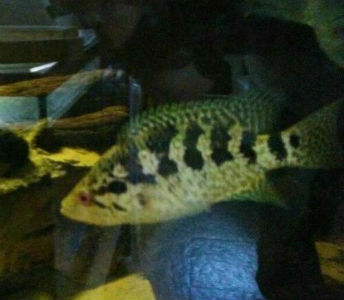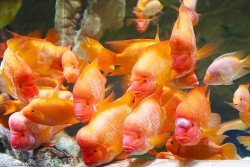Parachromis managuensis are found in Laguna de Apoyo, Nicaragua
 Jaguar cichlids are a large cichlid native to freshwater habitats in Central America, where they are found from Honduras to Costa Rica. The scientific name or species name refers to Lake Managua in Nicaragua from where the holotype was obtained. This cichlid is also a food fish and is also found in the aquarium trade where it has a number of common nicknames including the jaguar cichlid, managuense cichlid or managua cichlid, guapote tigre, Aztec cichlid, spotted guapote and jaguar guapote.
Jaguar cichlids are a large cichlid native to freshwater habitats in Central America, where they are found from Honduras to Costa Rica. The scientific name or species name refers to Lake Managua in Nicaragua from where the holotype was obtained. This cichlid is also a food fish and is also found in the aquarium trade where it has a number of common nicknames including the jaguar cichlid, managuense cichlid or managua cichlid, guapote tigre, Aztec cichlid, spotted guapote and jaguar guapote.Managuensis are a very popular species of its genus and is kept in community tanks with other large cichlids like Midas cichlids. As with all members of the genus, the jaguar cichlid is a large, aggressive and territorial member of the Cichlidae. Jaguar cichlids display a shade of yellow/bronze throughout the body. This yellow coloration is then scattered with vivid black spots which are seen all along the flanks and gill plates. There is a series of several large black dots then run horizontally along the lateral line area. The fins are often a dark to black coloration, especially when in spawning coloration.
The female is similarly colored, but generally smaller than the male. The female will also lack the elongated extensions to the dorsal fins. It is highly advisable that a breeding pair of jaguar cichlids, or any other member of the Parachromis, are kept isolated in a breeding tank, with the exception of very large aquaria, as a breeding pair will become hyper-aggressive, and pose great danger to any other fish in the aquarium.
The Managuense Cichlid, commonly known as the Aztec Cichlid or the Jaguar Cichlid, is a colorful cichlid with a distinctive pattern. Young Managuense Cichlids have a dull silver/gold body with dots going along it. The dullness increases as they get older, until they reach sexual maturity, at which point the drab blotches darken, finally becoming black with an uneven pattern similar to that of the jaguar cat. The backdrop is shiny and has a subtle purple hue to it. Females have fewer spots than males. The lower lip often protrudes over the upper lip, exposing part of the front teeth.
The Managuense Cichlid may be kept as a youngster in a 50 gallon aquarium. An aquarium of at least 70 gallons is required for an adult. They demand a large amount of open swimming space as well as hiding spots. Because the Managuense Cichlid is a burrower and will rip up plants, the tank's bottom should be coarse gravel with no plants.
Although this cichlid is a predator, it may be kept with other big cichlids, albeit it may not tolerate cichlids of the same hue. Any fish that can fit inside the Managuense Cichlid's mouth should not be housed in the same tank as it.
Males are usually bigger, have pointed dorsal and anal fins, and are more vibrantly colored. It might be difficult to breed in an aquarium, but Managuense Cichlids are wonderful parents who create nuclear families. The female may lay up to 5,000 yellow eggs in her lifetime.
Most prepared and frozen meals, including freeze-dried bloodworms, tubifex, and ocean plankton, as well as flake food and Cichlid pellets, will be eaten by the Managuense Cichlid.
Jaguar cichlids for sale

Jaguar Cichlid Video
References
Parachromis managuensisJaguar cichlid in Laguna de Apoyo, Nicaragua
Jaguar Cichlids for Sale Online with Free Shipping
Gold Jaguar Cichlid for Sale (Parachromis managuensis)
Jaguar cichlid breeding pair and Jaguar cichlid breeding behavior
Jaguar cichlid fish colors and color change for Parachromis managuensis species





